Imagine walking through Morocco’s ancient medinas. You’re surrounded by history that shows the country’s rich heritage. Morocco has seven medinas on the UNESCO World Heritage Site list. Each one offers a unique glimpse into the country’s diverse past.
Visiting Morocco’s ancient medinas is like stepping back in time. You’ll see historical sites that are centuries old. The medinas mix European and Arab styles in architecture, food, and culture. Whether you love history, culture, or just want to soak up the atmosphere, Morocco’s medinas are a must-see.
Introduction to Moroccan Medinas
Moroccan medinas are a fascinating mix of history, culture, and architecture. Five of them are UNESCO World Heritage Sites, including Fez, Marrakech, Essaouira, Tetouan, and Aït Benhaddou. Each medina is a treasure trove of discovery, with bustling souks and historic landmarks. They all showcase Morocco’s rich heritage.
Key Takeaways
- Seven medinas in Morocco are included on the UNESCO World Heritage Site list
- The University of Al-Qarawiyyin in Fes is the world’s oldest university still in operation
- Marrakech is referred to as the “Red City” due to its red-colored walls
- Essaouira’s medina is characterized by a mix of European and Arab influences
- Fez’s medina is considered one of the largest car-free urban areas in the world
Introduction to Moroccan Medinas
Moroccan medinas are the heart of the country’s cities. They offer a glimpse into its rich history and cultural heritage. These ancient cities have traditional architecture, narrow streets, and vibrant souks. Many of Morocco’s medinas are UNESCO World Heritage Sites, showing their cultural and historical value.
Visitors can explore the medinas to see the cultural wonders of Morocco. They are filled with historic landmarks, bustling markets, and delicious food. The medinas are not just cultural and historical sites. They are also thriving communities that show the country’s diverse cultural influences.
- Narrow streets and alleys
- Traditional architecture, such as riads and mosques
- Vibrant souks and markets
- Historic landmarks and cultural attractions
By visiting the medinas, tourists can learn more about Morocco’s rich history and culture. They can see the unique mix of Arab, Berber, and Mediterranean influences that shape the country’s society.
The Medina of Marrakech
Exploring Morocco’s medinas is a must-do experience. The Medina of Marrakech is one of the most famous and vibrant ancient city centers in Morocco. It has a rich history and cultural significance, making it a must-visit for anyone interested in Morocco’s heritage.
The medina is home to key attractions like the Koutoubia Mosque and the Jemaa el-Fnaa square. At night, the square turns into a bustling open-air restaurant.
Visitors can expect to walk nearly 30,000 steps a day in the Medina of Marrakech. They’ll discover various attractions and souks that make this ancient city unique. Historical landmarks like the Ben Youssef Madrasa and the Museum of Moroccan Arts and Crafts showcase the country’s rich cultural heritage.
For those looking to experience local cuisine, a traditional breakfast omelet sandwich costs around 10 dirhams. A hearty fava bean soup costs about 5 dirhams.
Some key attractions and activities in the Medina of Marrakech include:
- Visiting the Koutoubia Mosque, a 12th-century landmark that underwent restoration in the 1990s
- Exploring the souks, including the Spice Souk, Textile Souk, and Metalwork Souk
- Taking a stroll through the Jemaa el-Fnaa square, which comes alive at night with food stalls and entertainment
- Discovering the intricate Islamic architecture of the Ben Youssef Madrasa
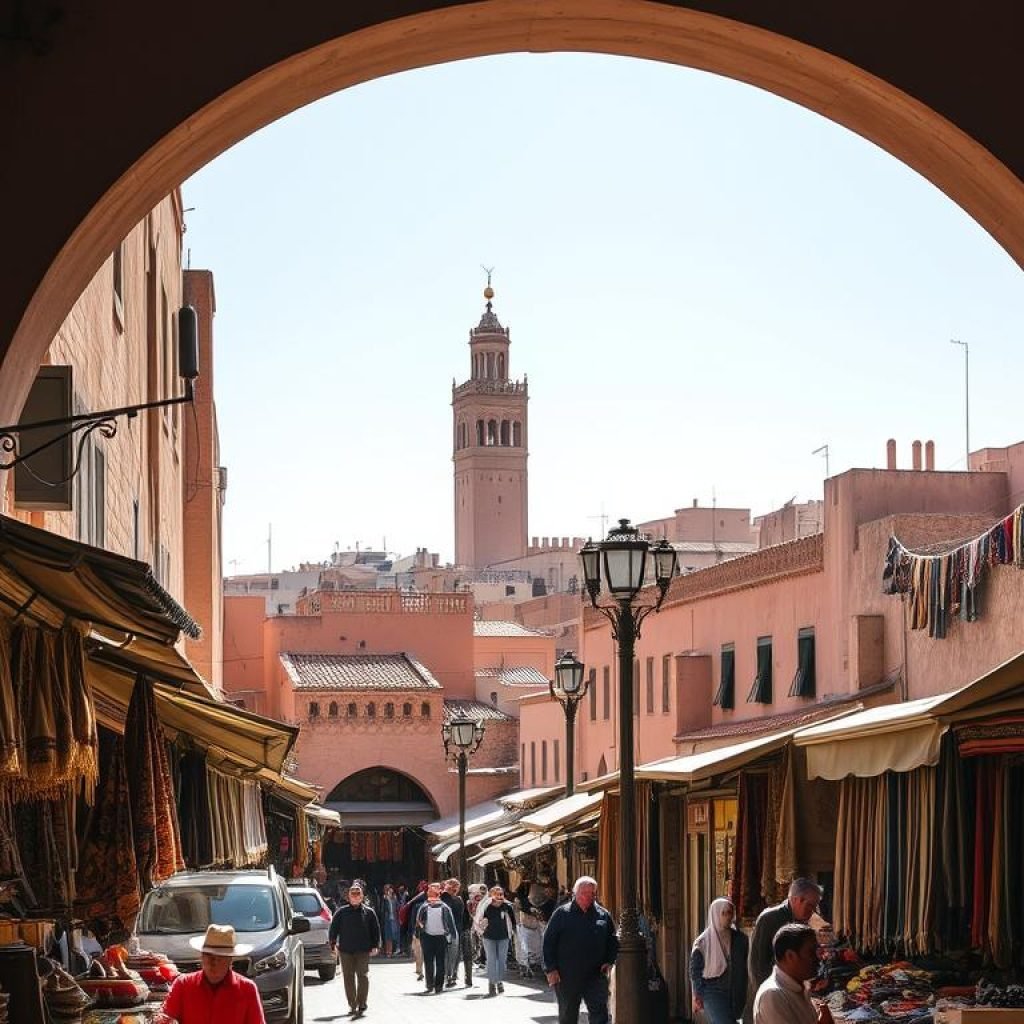
The Medina of Marrakech is a UNESCO World Heritage site. It highlights its cultural and historical significance. With its labyrinth of narrow, winding streets and vibrant souks, this ancient city is a must-visit for anyone exploring Morocco’s medinas.
Whether you’re interested in history, culture, or simply experiencing the local way of life, the Medina of Marrakech has something to offer.
The Medina of Fes
The Medina of Fes is a UNESCO World Heritage Site. It’s a key example of Historical sites in Morocco. It shows the country’s deep Moroccan heritage.
This ancient city is full of traditional crafts. You can see pottery, weaving, and metalwork. These skills have been passed down for generations.
The medina has a maze of narrow streets and alleys. You’ll find landmarks like the Al-Attarine Madrasa and the Bou Inania Madrasa. They show off traditional architecture in Morocco.
Visitors can wander the souks. They sell textiles, spices, and handicrafts.
Some top spots in the Medina of Fes include:
- Al-Attarine Madrasa
- Bou Inania Madrasa
- Chouara Tannery
- Dar Batha Museum
- Funduq al-Najjariyyin
The Medina of Fes is a must-see for those interested in Historical sites in Morocco. It’s a chance to dive into the country’s rich Moroccan heritage and traditional architecture in Morocco.
The Medina of Essaouira
The Medina of Essaouira is a gem on Morocco’s Atlantic coast. It’s a cultural wonder that shows off the country’s rich history and architecture. As a key historical city in North Africa, Essaouira’s medina is a top spot for those who love exploring Morocco’s medinas.
Its architecture is a mix of 18th-century Arabic and Muslim styles and European influences. This makes the medina a treasure trove of cultural and historical importance.
The Medina of Essaouira is known for its lively arts scene, with a focus on woodworking and textiles. Visitors can wander the narrow streets and alleys, finding artisan shops and galleries. These places showcase the talents of local craftsmen.
The medina also hosts the famous Jezebel Festival, celebrating music, art, and culture. It’s a favorite among tourists, offering many traditional restaurants and cafes. These places serve local dishes and drinks.
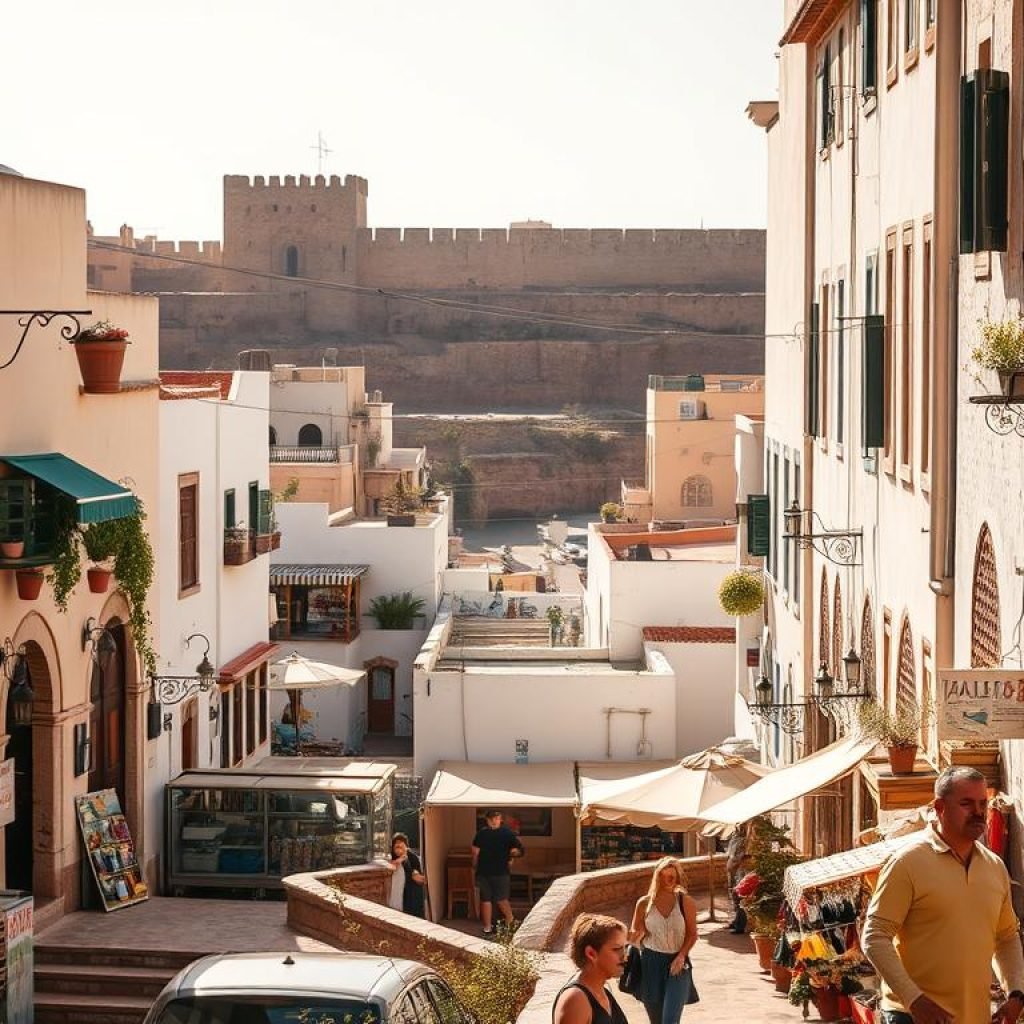
The Medina of Essaouira has four gates and old walls, showing European military architecture. It’s also called “The windy city” because of its consistent winds. With its deep cultural heritage and historical value, the Medina of Essaouira is a must-see for anyone interested in Morocco’s cultural wonders and historical cities.
The Medina of Tangier
The Medina of Tangier is a special place where cultures meet. It sits at the crossroads of Europe and Africa. This ancient medina in Morocco is filled with historical sites, showing the country’s rich heritage.
Visitors can see both traditional and international styles in the city. This mix is seen in the architecture, food, and lifestyle. It’s a place where old and new blend together.
Some top spots in the Medina of Tangier include the Kasbah, the Medina, and the Grand Socco. These places give a peek into the city’s past and culture. They are key for anyone wanting to learn about Morocco’s history.
The medina is also known for its food. It offers a variety of dishes, from traditional Moroccan to international flavors. This makes it a great place to try new foods.
- Historical landmarks, such as the Anglican Church of Saint Andrews and the Sidi Bouabid mosque
- Vibrant culture, with a mix of traditional and international influences
- Local cuisine, showcasing the blend of cultural influences that have shaped the city’s culinary scene
The Medina of Tangier is a unique and interesting place. It shows the best of Morocco’s ancient medinas and its rich heritage.
The Medina of Tétouan
Tétouan is a lively Moroccan city with a deep Arab-Andalusian heritage. It’s famous for its traditional architecture in Morocco, showing the Spanish influence. The Medina of Tétouan is a UNESCO World Heritage Site. It highlights the city’s cultural significance and its unique mix of Moroccan and Spanish styles.
When you visit the Medina, you can wander through its narrow alleys and lively souks. You’ll find traditional markets and local shops. The city also has museums like the Museum of Archaeology and the Museum of Ethnography. They showcase the city’s cultural wonders of Morocco. For more info on things to do in Tétouan, check out Tétouan’s tourist attractions.
The people of the Medina go shopping every day. This habit helps them stay connected with each other. The city’s artisanal school, Dar Sanaa, teaches traditional Moroccan crafts. Some key attractions in the Medina include:
- The Royal Palace of Tétouan, known for its intricate tile work and traditional Moroccan architecture
- The Kasbah of Tétouan, offering stunning views of the Medina, the Rif Mountains, and the Mediterranean Sea
- The Square of Hassan II, a central spot for locals and tourists, surrounded by cafés and restaurants
The Medina of Tétouan is a must-see for anyone wanting to explore Morocco’s rich culture and history. It offers a unique blend of traditional architecture, cultural significance, and a lively community.
Exploring the Souks: A Shopping Experience
Exploring Morocco’s medinas is thrilling, and visiting the souks is a highlight. These ancient city centers are filled with goods like traditional crafts, spices, and textiles. Walking through the narrow alleys, you’ll find unique shopping experiences that show off Morocco’s rich culture.
In the souks, you can find traditional clothing, handmade crafts, and local food products. The souks are organized into sections like the carpet souk and the spice souk. Knowing how to bargain and support local artisans is key to a great shopping experience.
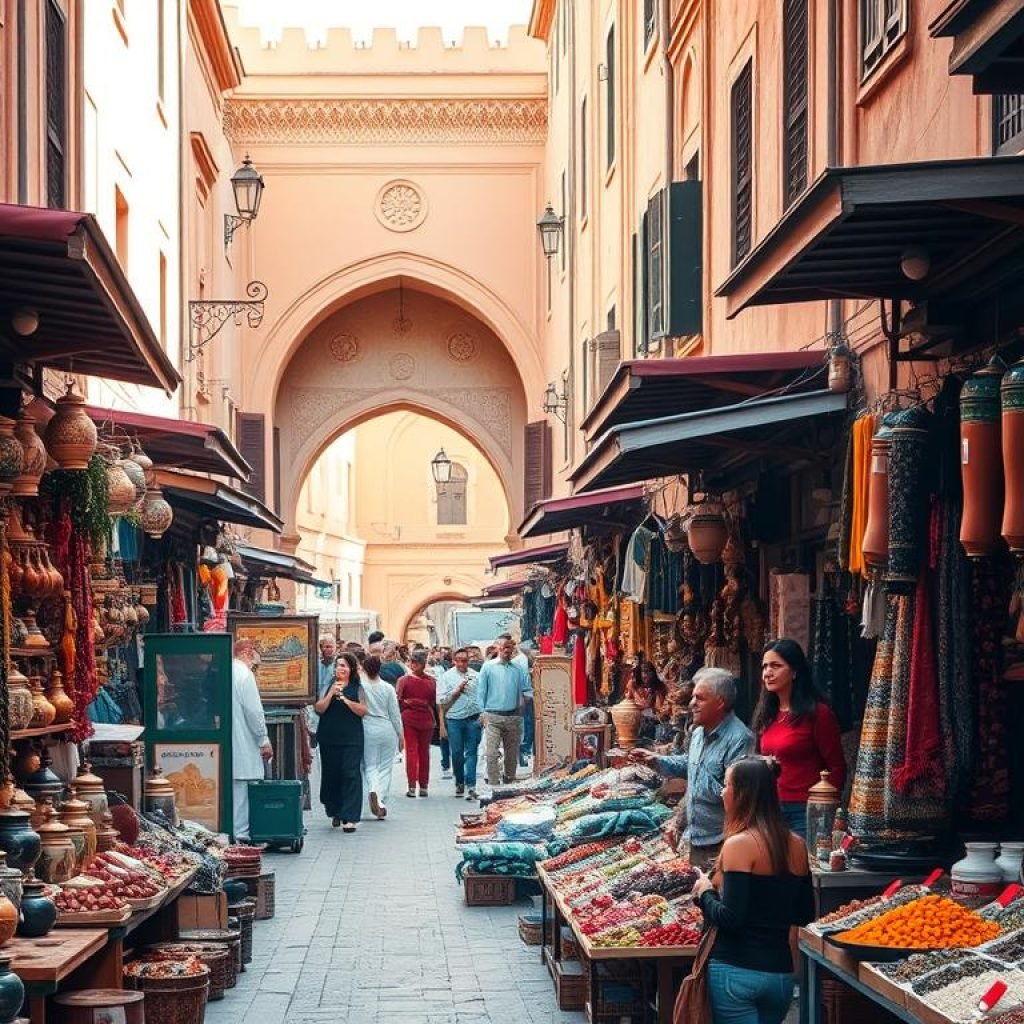
For bargaining, start with a low offer and be respectful. Walking away if the price isn’t right is okay. By buying from local artisans, you get unique items and help the local economy. The souks offer something for everyone, from Moroccan rugs to handmade crafts.
Exploring the souks is a sensory experience. You’ll see colorful displays and hear vendors calling out. The souks’ history, cultural importance, and shopping make them unforgettable. Visiting the souks will give you memories that last a lifetime.
Historical Figures and Events
Morocco’s historical heritage is rich and diverse. It shows the country’s complex past through many historical sites. The earliest known human presence in Morocco dates back at least 400,000 years. The recorded history starts with the Phoenician colonization between the 8th and 6th centuries BCE.
Many cultures have shaped Morocco, including the indigenous Berber monarchs, the Roman Empire, and the Muslim conquest of the Maghreb in the early 8th century CE. These influences have made the traditional architecture in Morocco unique. The Koutoubia Mosque and the Al-Qarawiyin Mosque are great examples.
Some key events and figures have shaped Morocco’s historical sites include:
- The Idrisid dynasty, which ruled from 789 to 974 CE and is recognized as the first Moroccan state
- The Almoravid dynasty, which ruled from 1060 to 1147 CE and founded the city of Marrakech
- The Saadian dynasty, which ruled from 1554 to 1659 CE and amassed significant wealth through trade and conquest
These historical figures and events have left a lasting legacy in Morocco. Many historical sites in Morocco still stand today. They are a testament to the country’s rich Moroccan heritage.
Preservation Efforts and Challenges
Exploring Morocco’s medinas shows the rich culture of Morocco. These historical cities in North Africa have amazing architecture and lively traditions. Saving these medinas is a big job, needing careful conservation to keep their culture and history alive.
Groups like UNESCO help with preservation, offering technical and financial aid. For example, the Fez Medina, a UNESCO World Heritage Site, has seen a lot of restoration. This work includes training local artisans in old building methods.
Some important facts about Fez’s preservation efforts are:
- 9,400 historic monuments and buildings, making it one of the most well-preserved medieval cities in the world
- 13,385 historic buildings within the medina
- 3,000 historic monuments, including the al-Qarawiyyin Mosque and the al-Attarine Madrasa
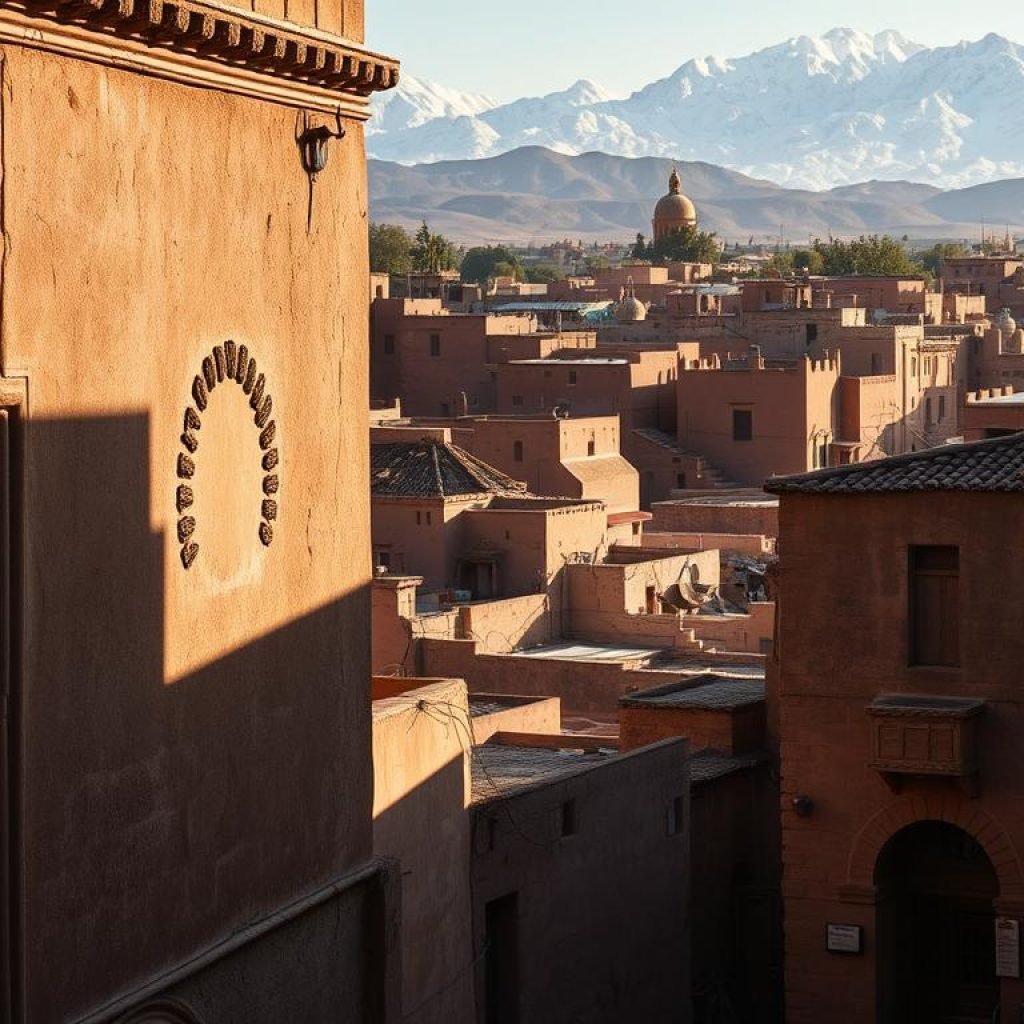
The community plays a big part in saving the medinas. Projects aim to get locals involved in conservation. This helps them feel a part of it and makes preservation efforts last longer, keeping Morocco’s cultural wonders alive for future generations.
| Category | Budget Allocation |
|---|---|
| Infrastructure investments | 52.9% |
| Rehabilitation of buildings | 22.1% |
| Restoration of monuments | 11% |
| Environmental protection | 6.6% |
| Cultural and tourism development | 4.9% |
| Training and institutional reinforcement | 1.3% and 1.2% |
Cultural Festivals in the Medinas
Morocco’s ancient medinas are rich in history and architecture. They also host cultural festivals all year round. These festivals show off the country’s Moroccan heritage and draw tourists from everywhere. The medinas come alive with colors, sounds, and smells, perfect for culture lovers.
Some top festivals include the Marrakech Popular Arts Festival and the Fes Festival of World Sacred Music. The Essaouira Gnaoua and World Music Festival is also a hit. These events celebrate historical sites in Morocco and foster cross-cultural understanding. Guests get to see Morocco’s mix of traditional and modern music, dance, and art.
Popular Events and Celebrations
The festivals in Morocco’s medinas highlight the country’s cultural diversity. From ancient medinas to modern cities, there’s always something to celebrate. These festivals are a great way to dive into local culture and meet the friendly Moroccan people.
Impact on Tourism
The cultural festivals in Morocco’s medinas boost tourism. They draw visitors from all over and offer a unique glimpse into the country’s Moroccan heritage. These festivals promote cultural exchange and help the local economy a lot.
Conclusion: The Charm of Ancient Medinas
The ancient medinas of Morocco are a treasure trove of history and culture. They offer a chance to step into a world where old and new meet. Here, you can find bustling souks filled with handmade goods and historic sites that show the nation’s varied influences.
These medinas are alive with skilled craftsmanship and traditions passed down through generations. You might be amazed by the stunning architecture, excited by the local food, or simply swept away by the lively atmosphere. Visiting Morocco’s medinas is an experience you won’t forget, leaving a lasting impression on your heart and memories.


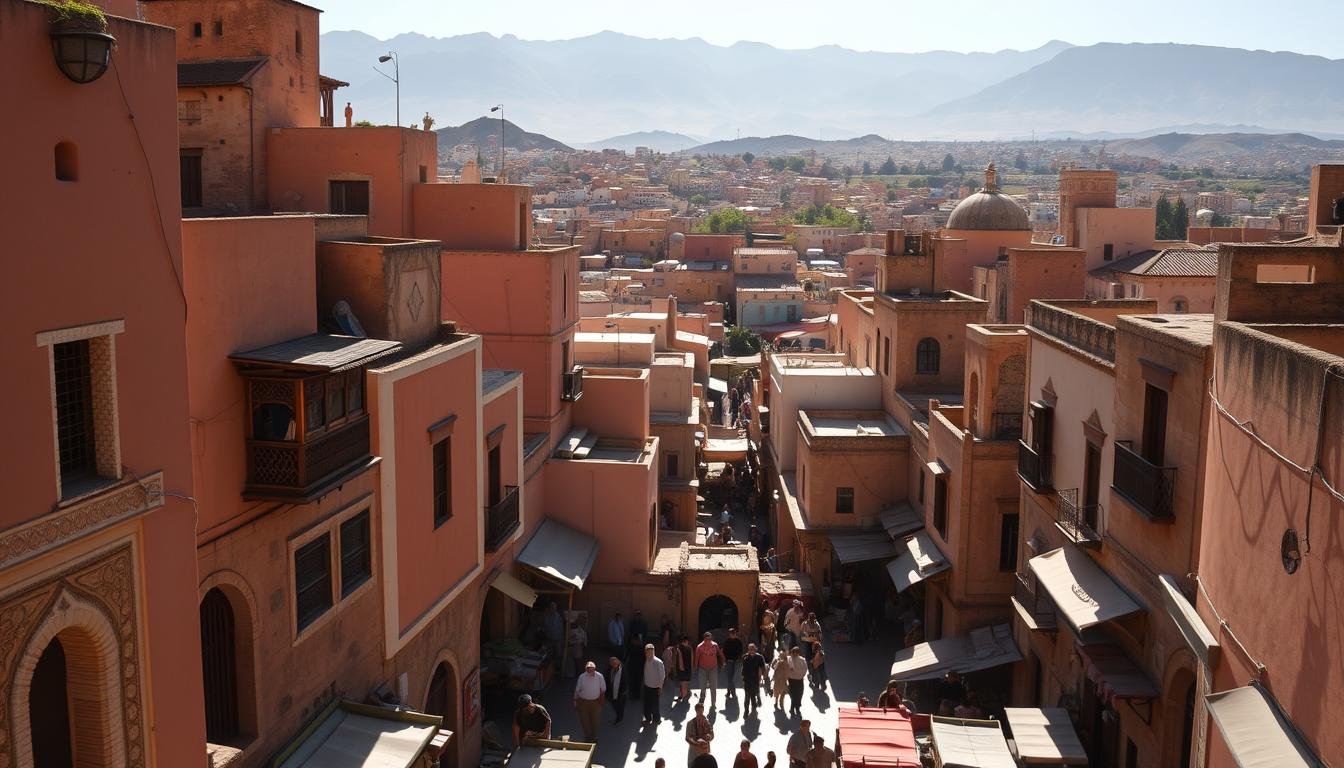

Comment (0)